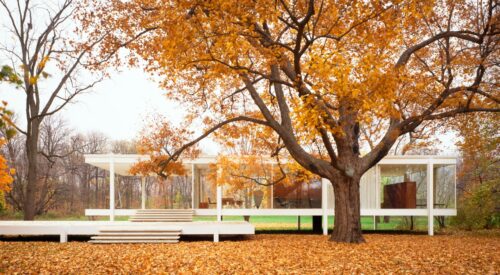
By Judy Carmack Bross

Edith Farnsworth House
“Just when you thought you knew everything about the Dr. Edith Farnsworth House, my book will hopefully prompt you to want to re-visit Plano,” Michangelo Sabatino, author of the newly published The Edith Farnsworth House: Architecture, Preservation, Culture.
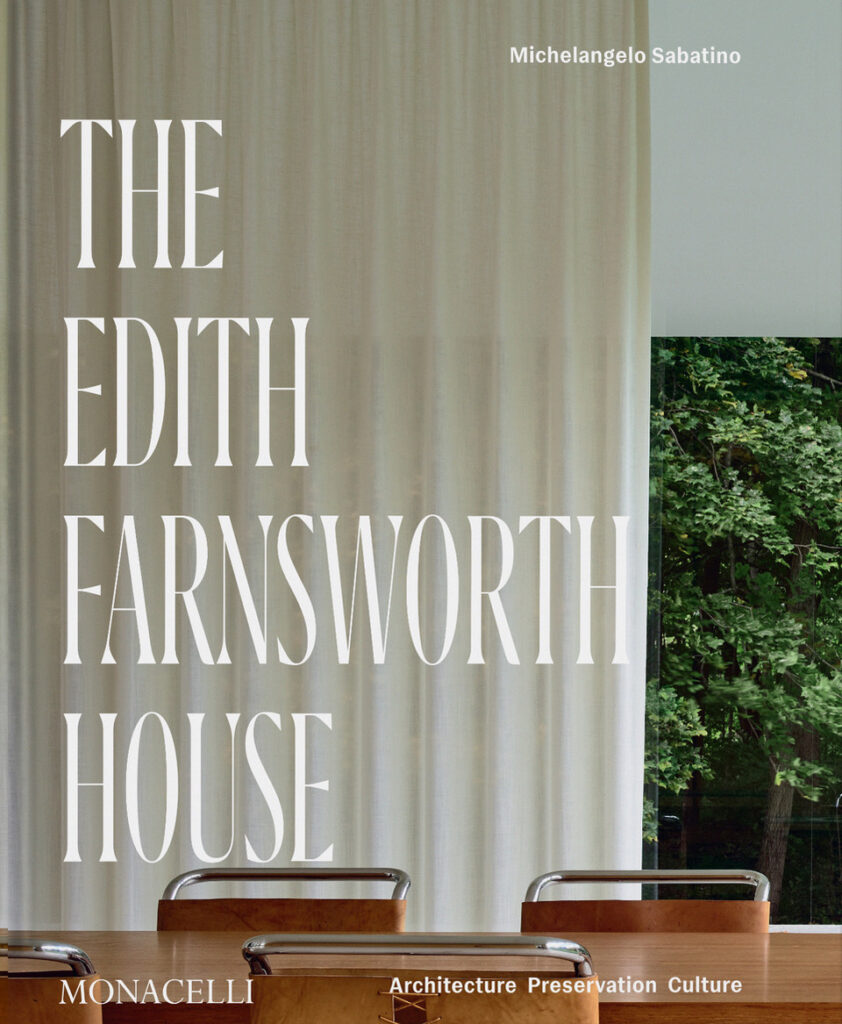
This architectural history book is filled with magnificent photographs of the house Mies van der Rohe designed and constructed between 1945-1951; it also presents a revealing social narrative by way of never before published memoirs of the woman who commissioned the house along with an interview with the cosmopolitan British lord who bought it and twice restored it. The book is beautiful, scholarly and fascinating reading all at the same time proves why the house established Mies’s reputation leading to a super productive career in Chicago and beyond.

Dr. Edith Farnsworth

Mies van der Rohe Photo: Helen Balfour Morrison (copyright Newberry Library)

Lord Peter Palumbo, on the Mies day bed
A House & Gardens article from 1952 described the Farnsworth House as a “glass shell that floats in the air.” One of the world’s treasures of modern architecture, and one of only four mid-century modern structures to be listed on the National Register of Historic Places, it is now accessible to the public thanks to the National Trust for Historic Preservation, its new owner. Designed as a one-room weekend house on a rural site on the Fox River in Plano, just west of Chicago, it speaks not only of its brilliant architect Mies van der Rohe but also of his client, Northwestern Memorial Hospital nephrologist Dr. Edith Farnsworth, and its second owner, Lord Peter Palumbo.
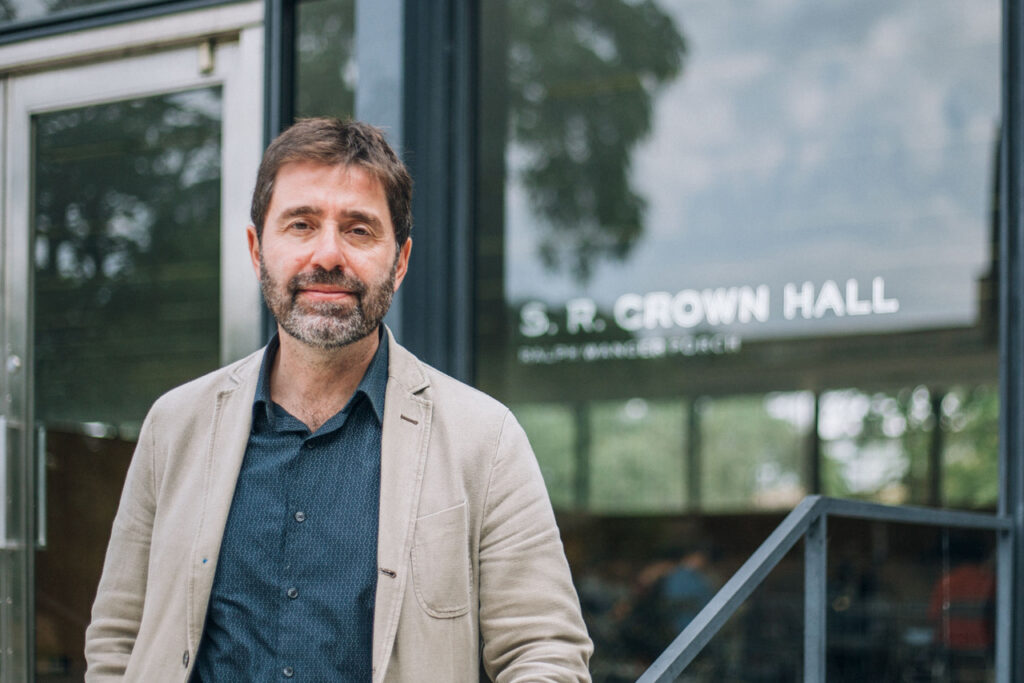
Author Michelangelo Sabatino
The book contains contributions by Scott Mehaffey, Dietrich Neumann, Ron Henderson, and Hilary Lewis. Michelangelo Sabatino is a publicly engaged educator, historian, curator, and preservationist whose research and writing focuses primarily on the built environment of the twentieth century. Sabatino taught at Yale University and the University of Houston before his appointment to IIT’s College of Architecture. In addition to having served as the Interim Dean, he currently directs the PhD Program in Architecture and is the Inaugural John Vinci Distinguished Research Fellow.
Docomomo US just announced that Sabatino is one of 16 recipients of the 2024 Modernism in America Awards for the book.
Scott Mehaffey, Executive Director and Curator of the Edith Farnsworth House Historic Site for the National Trust, writes in the foreword: “This thorough yet accessible book will ensure that the Edith Farnsworth House will continue to serve as a nexus of history, art, and nature with insightful stories of the past and inspiring lessons for the future.”

Mies visiting construction site with project supervisor Myron Goldsmith, Fall 1950
The brilliant Dr. Farnsworth, termed in the book as Mies’s intellectual equal and known to be a consequential patron of modern architecture, is described as going from “enthusiastic client to disillusioned owner”.
Dr. Farnsworth purchased 60 acres from Col. Robert R. McCormick in 1945 with the hope to create a place where she could “retreat, reflect and refresh”. Her hours at the Hospital were lengthy and she did much work with underserved clients.
Edith fell out with Mies over furniture and bills and counter suits flew. When she retired, she put her house up for sale and moved to Italy. In her handwritten memoirs executed during the last decade of her life she wrote that she would not pay further expenses including for pink suede Barcelona chairs which she believed Mies had ordered without her permission. “I think a Barcelona chair is very handsome but totally unsuitable for a small country house—the place would look like a Helena Rubinstein salon. There is already the local rumor has it that it is a tuberculosis sanitarium. The fact is Mies has no taste. I would hate to be forced to break with him but I would never consent to his ideas on furnishing. One’s house is almost as personal as one’s skin.”
In her memoirs she quotes Mies telling her: “You go back to your nephrites where you belong and leave me to build your house without interference.”
Sadly, Dr. Farnsworth writes about the necessity of putting the house on the market that “because of the grotesque hearings, hundreds of persons have trampled on my plantings and invaded the solitude of my shore.” Selling the house to Lord Peter Palumbo for $120,000, Farnsworth died in 1977 after a decade in which she wrote her memoirs and translated poetry in a villa near Florence.
In 2021, Sabatino interviewed Lord Palumbo and his wife Lady Hayat Palumbo. Peter wanted to bring the house back to Mies’s vision, completing two major renovations and purchases of additional farmlands during their 30 years owning the property. Throughout their ownership Lord and Lady Palumbo welcomed many friends there, including John Cage, Ellsworth Kelly, Claes Oldenburg and Norman Foster. In his interviews with Sabatino, Palumbo described his discovery of the Farnsworth House:
“At Eton, my housemaster Oliver van Oss had an encyclopedic knowledge of the arts. He showed us photographs of the Farnsworth House and when I saw them I thought to myself that I’ve never seen anything as beautiful as this or as historic. I mean, it was like the contemporary version of the Temple of Paestum, or somewhere like that, springing up in a meadow. Purchasing the Farnsworth House came out of the blue. When I was in Chicago it was just being listed for sale.”
We spoke with Sabatino about the Edith Farnsworth House, its cast of characters and the lessons learned from the difficulties that arose. We noticed that the cover shot is not of the outside of the iconic structure, but from the inside, looking out. “So many photos crop out the view of nature one has when looking out of the house. It is set on agrarian farmland, and most photos take the country out of the house,” he said.
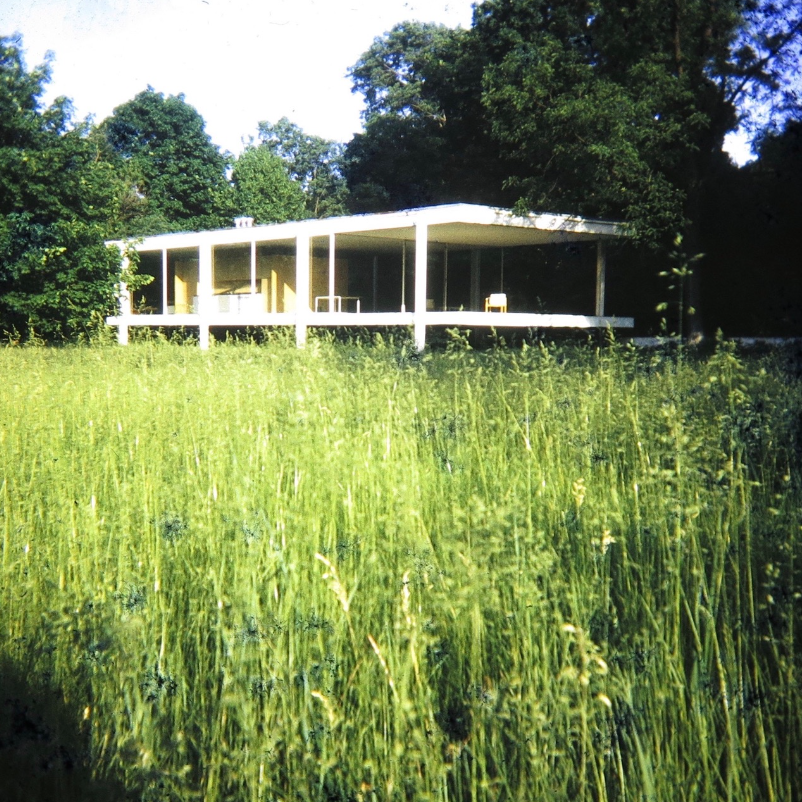
View of the Farnsworth House from the meadow

The house and the river, fall 1979
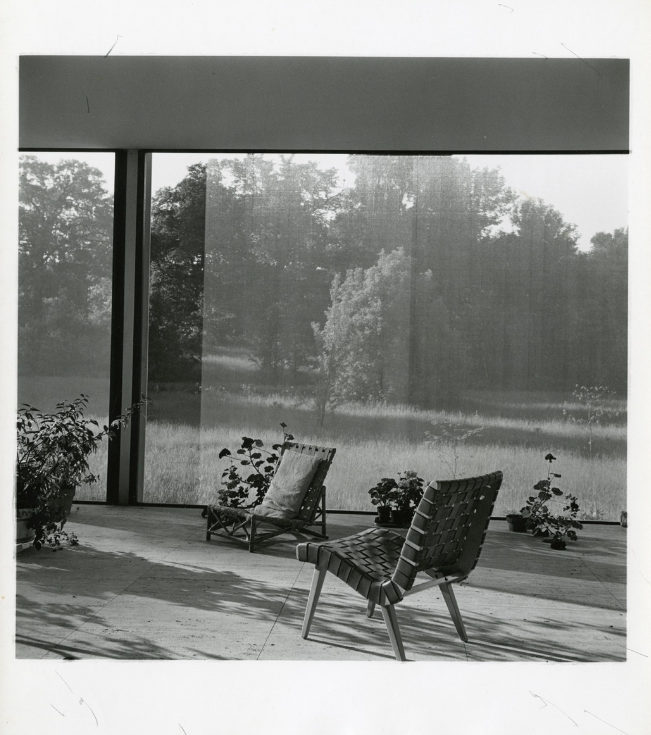
Screened porch with view out to meadow, likely photographed by Edith Farnsworth, mid-1950s, Courtesy The Newberry Library
CCM: You have said that that people may think that they know all there is to know about the Farnsworth House but your book shows that that isn’t true. What are some of these new areas that you provide?
MS: The book gives a prominent role to not only the architect Mies van de Rohr but the individuals/organizations involved in its “lives” over time: Edith, as commissioning client and patron, and Mies as well as Lord and Lady Palumbo and the National Trust for Historic Preservation, current owner even though it was initially purchased together with Landmarks Illinois.
Taking into account the different “lives” of the iconic house over time, through different inhabitants, is a useful way of writing a more layered architectural and social history.
CCM: Nature and the setting with the beautiful black sugar maple trees, play such an important role in the book. You talk about the view from inside the house, not only the view of the iconic house itself. How important as we study architectural masterpieces, is the view from inside out.
MS: All too often, buildings are photographed from the outside in because since it is somewhat easier. It doesn’t require being granted permission to photograph interiors and you typically don’t need special lighting. In order to experience the space of a building, a house or church for that matter, you must enter it; appreciating a facade is not having a spatial experience with the building unless it is part of a larger whole.
CCM: Mixed with architectural detail on the house’s construction is the sometimes fraught relationships between the owner, Edith Farnsworth, the architect Mies Van de Rohr, and the second owner Peter Palumbo. What was the most important force driving each and how did they react to one another.
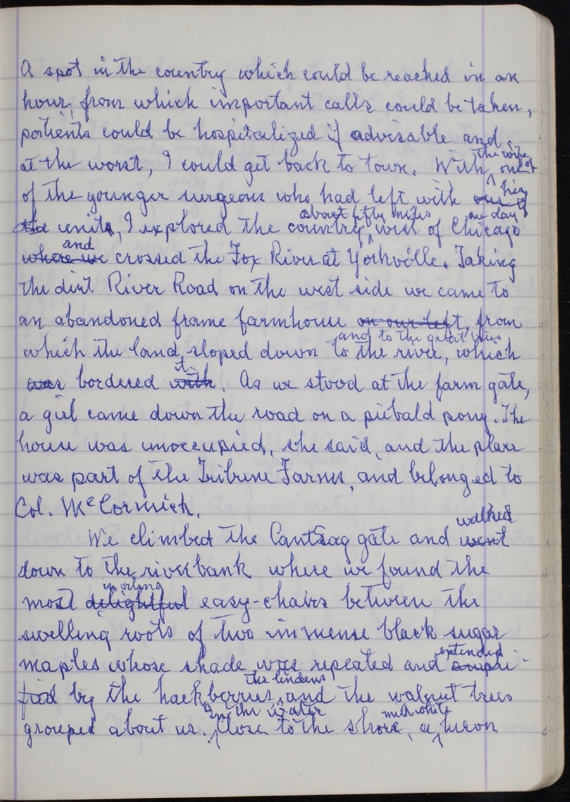
Edith Farnsworth Memoirs, Courtesy The Newberry Library
MS: Edith writes in her memoirs, published for the first time in my book, that she wanted to have a country house where she could reflect. She did not want the house to feel like an austere art gallery. Palumbo channeled Mies’s aesthetic when it came to furniture. He hired Dirk Lohan to design the bed, desk, and dining room and introduced a number of Mies designed chairs.
CCM: In her previously unpublished memoirs we encounter the great disappointment of Dr. Edith Farnsworth and her legal wars with Mies. How does this propel your narrative?
MS: I am not so much focused on the legal wars as I am on allowing space for Edith’s role as client/patron to emerge in terms of what kind of country house she wanted to have and why it is important to ensure that the client’s perspective is acknowledged when one writes about a building.

Edith with her dog Miss Amy, February 1952
CCM: Why is it important to visit Farnsworth House.
MS: Even though a book might be exciting to hold, it is always best to see buildings for yourself! Visiting is essential in order to really experience the riverine and agrarian site in all of the seasons and with different senses. You can hear the cicadas, listen to the wind and birds. This is what Edith wanted to experience. She wanted to relax in the country and that is why she also insisted on having a screened porch and two hopper windows. She didn’t want to live in a hermetically sealed glass box.
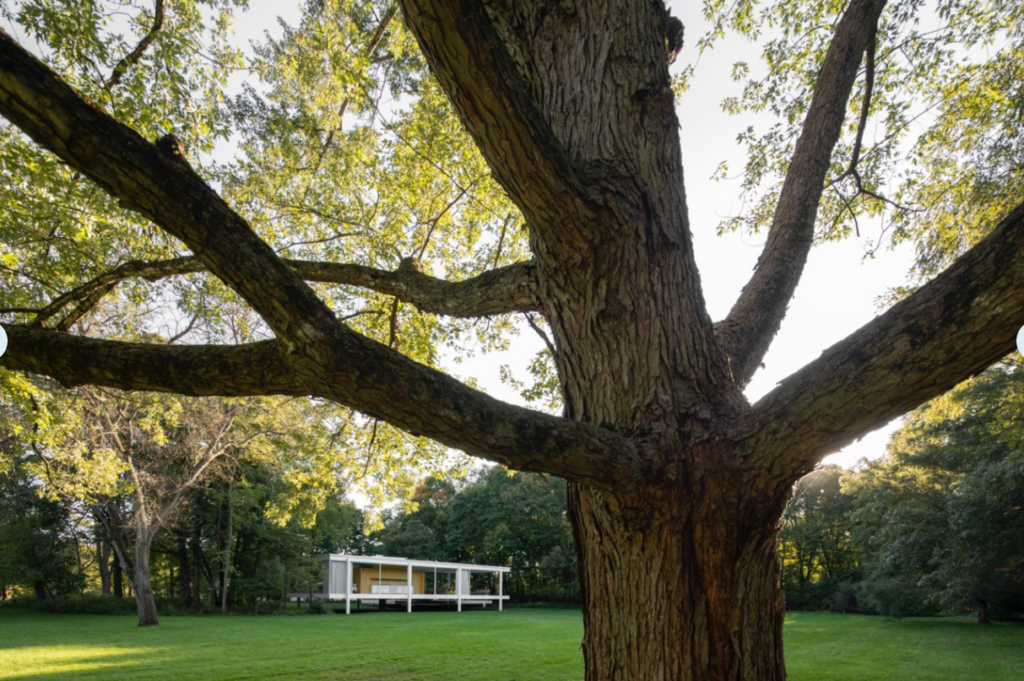
Edith Farnsworth House and lawn in summer, 2014
For readers who have never been or haven’t been for a while to the Edith Farnsworth House, we encourage you to take advantage of a drive soon to see fall colors and experience the house. The book may be purchased to help this National Trust for Historic Preservation site.
Visit the author’s website at: www.michelangelo-sabatino.com



